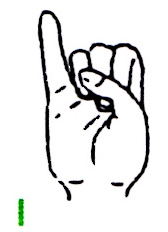I
![]()
This article deals primarily with the origin, presentation, and pronunciation of the letter I. For the lowercase letter ı, see İ. For other meanings of I, see I (disambiguation).
![]()
I-Tüpfelchen is a redirect to this article. See also: I-Tipferl.
Ii
I, i (pronounced: [ʔiː]) is the ninth letter of the classical and modern Latin alphabet. It is a vowel (although it can be pronounced consonantally under certain conditions). The letter I has an average frequency of 7.55 percent in German texts. It is thus the third most frequent letter in German texts.
The finger alphabet for the deaf and hard of hearing represents the letter I by stretching the little finger upwards in a closed fist with the thumb in front of it.

Letter I in the finger alphabet
Source
|
|
|
|
|
|
| Arm or hand (protosinaitic) | Phoenician Yodh | Greek iota | Etruscan I | Latin I |
In the Proto-Sinaitic script, the letter represents the symbol for a hand with one arm. Already in this alphabet, the symbol was begun to be greatly simplified, so that in part only the bending of the arm and the outline of the hand are recognizable. In the Phoenician alphabet the letter had the name Yodh (hand/arm) and stood for the semi-consonant [j] (as in young).
In the Greek alphabet the yodh was adopted as iota. The Greeks changed the phonetic value of the letter because of their vowel-rich language, it now stood for [i]. Already in the early Greek alphabet from the 7th century BC, the iota lost all affixes and became a simple vertical stroke.
Neither in the Etruscan nor in the Latin alphabet the letter was still substantially changed, the sound value [i] remained.
I longa
The I longa, an I extended beyond the line, was initially used in Latin from Sullan times to indicate the long spoken sound ī as opposed to short ĭ: felꟾcꟾ, vꟾcus. In the course of the imperial period this graphic distinction was lost and the I longa was used as a rarer variant for any i, sometimes also preferred for consonantal i̯ between vowels: eꟾus, eiꟾus.
In Unicode, the character is encoded as U+A7FE LATIN EPIGRAPHIC LETTER I LONGA.
The i dot
The i-dot is usually a small filled circle, but can also be adapted to the style of the respective font. In visual impression, its width is about the same as the stem of the lowercase "i", with a corresponding optical adaptation. Special forms occur, especially in handwriting, such as dash-shaped, ring-shaped, or heart-shaped i-dots. The capital I has no dot.
On the history of the i-dot, Grimm's dictionary states:
"As far as the minuscule is concerned, the i was written without a dash or punctuation until the 11th century. Only then did people begin to mark coinciding dashes with accents in order to prevent confusion. (...) already in the 12th century, the little stroke sometimes appears above the single í, but besides that, i's without stippling still occur frequently, and not infrequently, in older hss. such strokes were added later. the little stroke continued to become the long common punct, but punctures above the i (...) are hardly found before 1350".
- German Dictionary, vol. 4,2 (1877), sp. 2013
Colloquially, it is also referred to as i-Tüpfel or i-Tüpfelchen and in Southern German or Austrian as i-Tüpferl. In a figurative sense, "to dot the i" means to complete or refine something; if someone does this compulsively, he becomes an i-Tüpferlreiter or Tüpflischisser.
In typography, the i-dot in some typefaces merges with preceding letters in certain ligatures, e.g. in the ligatures fi and ffi. In this example, the ascender of the f merges with the i-dot of the following i.
i-dot and diacritical marks
If a diacritical mark (e.g. acute, grave, trema, etc.) is placed on the i, the i-dot is dropped. An i with trema is therefore written with two overdots (ï), not three.
Examples are: boîte (Fr. ), río (Span. ), lunedì (it. ), égoïste (Fr. ), īss (Lat. ), peteĩ (Grn.).
ı without dot
Iı İi
In most languages, the dot on the lowercase i is an integral part of the letter with no special meaning. However, in some languages, including Turkish and Azerbaijani, İ, i (each with a dot) and I, ı (each without a dot) represent two different sounds.
The named HTML character entities are İ for the large İ with a dot and ı for the small ı without a dot.
Search within the encyclopedia


